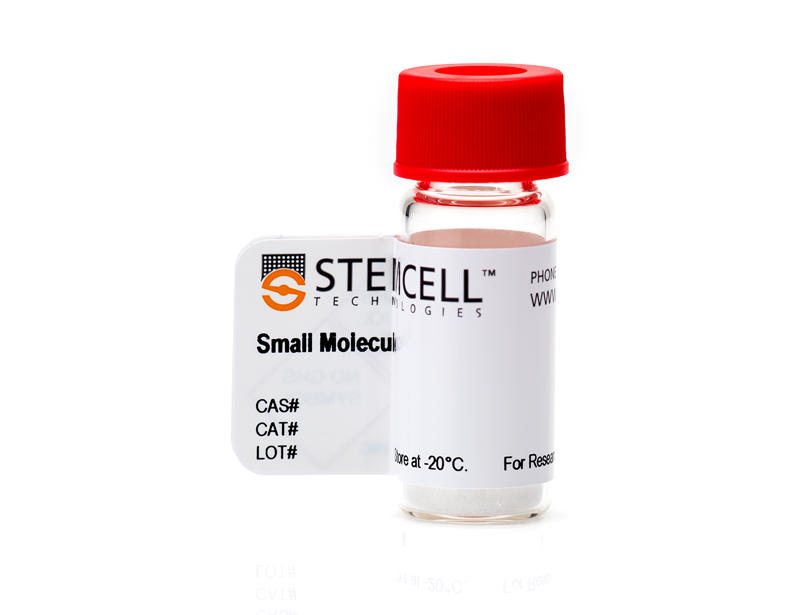概要
Sinefungin is a DNA methyltransferase (DNMT) inhibitor (IC₅₀ = 0.1 - 20 μM; Copeland et al.) and an analog of the methyl donor S-adenosyl-L-methionine (SAM; Nolan; Horiuchi et al.).
IMMUNOLOGY
· Antiparasitic activity against malarial, trypanosomal, and leishmanial species (Nolan; Trager et al.; Dube et al.).
· Inhibits Newcastle disease and vaccinia virus multiplication (Pugh et al.).
· Inhibits pneumococcal biofilm growth in vitro and colonization in an in vivo rat model (Yadav et al.).
IMMUNOLOGY
· Antiparasitic activity against malarial, trypanosomal, and leishmanial species (Nolan; Trager et al.; Dube et al.).
· Inhibits Newcastle disease and vaccinia virus multiplication (Pugh et al.).
· Inhibits pneumococcal biofilm growth in vitro and colonization in an in vivo rat model (Yadav et al.).
技术资料
| Document Type | 产品名称 | Catalog # | Lot # | 语言 |
|---|---|---|---|---|
| Product Information Sheet | Sinefungin | 73812 | All | English |
| Safety Data Sheet | Sinefungin | 73812 | All | English |
数据及文献
Publications (6)
BioMed research international 2014 JAN
Sinefungin, a natural nucleoside analogue of S-adenosylmethionine, inhibits Streptococcus pneumoniae biofilm growth.
Abstract
Abstract
Pneumococcal colonization and disease is often associated with biofilm formation, in which the bacteria exhibit elevated resistance both to antibiotics and to host defense systems, often resulting in infections that are persistent and difficult to treat. We evaluated the effect of sinefungin, a nucleoside analogue of S-adenosylmethionine, on pneumococcal in vitro biofilm formation and in vivo colonization. Sinefungin is bacteriostatic to pneumococci and significantly decreased biofilm growth and inhibited proliferation and structure of actively growing biofilms but did not alter growth or the matrix structure of established biofilms. Sinefungin significantly reduced pneumococcal colonization in rat middle ear. The quorum sensing molecule (autoinducer-2) production was significantly reduced by 92% in sinefungin treated samples. The luxS, pfs, and speE genes were downregulated in biofilms grown in the presence of sinefungin. This study shows that sinefungin inhibits pneumococcal biofilm growth in vitro and colonization in vivo, decreases AI-2 production, and downregulates luxS, pfs, and speE gene expressions. Therefore, the S-adenosylmethionine (SAM) inhibitors could be used as lead compounds for the development of novel antibiofilm agents against pneumococci.
Nature reviews. Drug discovery 2009 SEP
Protein methyltransferases as a target class for drug discovery.
Abstract
Abstract
The protein methyltransferases (PMTs) - which methylate protein lysine and arginine residues and have crucial roles in gene transcription - are emerging as an important group of enzymes that play key parts in normal physiology and human diseases. The collection of human PMTs is a large and diverse group of enzymes that have a common mechanism of catalysis. Here, we review the biological, biochemical and structural data that together present PMTs as a novel, chemically tractable target class for drug discovery.
Antimicrobial agents and chemotherapy 1987 OCT
Molecular target of the antileishmanial action of sinefungin.
Abstract
Abstract
Sinefungin, a natural nucleoside isolated from cultures of Streptomyces incarnatus and S. griseolus, is structurally related to S-adenosylhomocysteine and S-adenosylmethionine. Sinefungin has been shown to inhibit the development of various fungi and viruses, but its major attraction to date resides in its potent antiparasitic activity. This compound has been reported to display antiparasitic activity against malarial, trypanosomal, and leishmanial species. Very little is known about the antiparasitic mode of action of sinefungin. We found that S-adenosylmethionine was capable of reversing the inhibitory growth effects of sinefungin in Leishmania mexicana and that dATP was capable of reversing inhibitory effects of the drug on DNA polymerase activity when pyrophosphate release was measured. However, when incorporation of [3H]dTTP was used to measure DNA polymerase activity, no inhibition could be observed. Inhibition of DNA polymerase activity by sinefungin occurred only during the initial stages of purification of this enzyme, and inhibition by aphidicolin, a known DNA polymerase inhibitor, paralleled the inhibition by sinefungin. Neither sinefungin nor aphidicolin inhibited partially purified DNA polymerase. S-Adenosylmethionine synthetase was partially purified, and sinefungin, at levels active in vitro, had no significant effect. Sinefungin was significantly suppressive against both L. donovani and L. braziliensis panamensis infections in hamsters when compared with meglumine antimonate (Glucantime).
The American journal of tropical medicine and hygiene 1983 JAN
Antitrypanosomal activity of sinefungin.
Abstract
Abstract
Sinefungin, a naturally occurring antifungal antibiotic nucleoside containing an ornithine residue, linked by a C-C bond to C-5' of adenosine, cures mice infected with Trypanosoma brucei brucei, T. congolense, or T. vivax; the effect of the drug is more pronounced towards T. congolense. Anti-trypanosomal activity of sinefungin could be the result of the inhibition of transmethylation reactions or of polyamine biosynthesis--or both--in parasites.
Experimental parasitology 1980 AUG
Plasmodium falciparum: antimalarial activity in culture of sinefungin and other methylation inhibitors.
Abstract
Abstract
The Journal of biological chemistry 1978 JUN
Sinefungin, a potent inhibitor of virion mRNA(guanine-7-)-methyltransferase, mRNA(nucleoside-2'-)-methyltransferase, and viral multiplication.
Abstract
Abstract
Sinefungin (A9145) and a related metabolite, A9145C, were found to be potent inhibitors of Newcastle disease virion and vaccinia virion mRNA(guanine-7-)-methyltransferase and vaccinia virion mRNA(nucleoside-2'-)-methyltransferase. Both Sinefungin and A9145C were competitive inhibitors of these S-adenosyl-L-methionine-dependent enzymes having inhibition constants substantially less than S-adenosyl-L-homocysteine. These compounds also inhibited plaque formation by vaccinia virus in mouse L-cells.

 网站首页
网站首页




